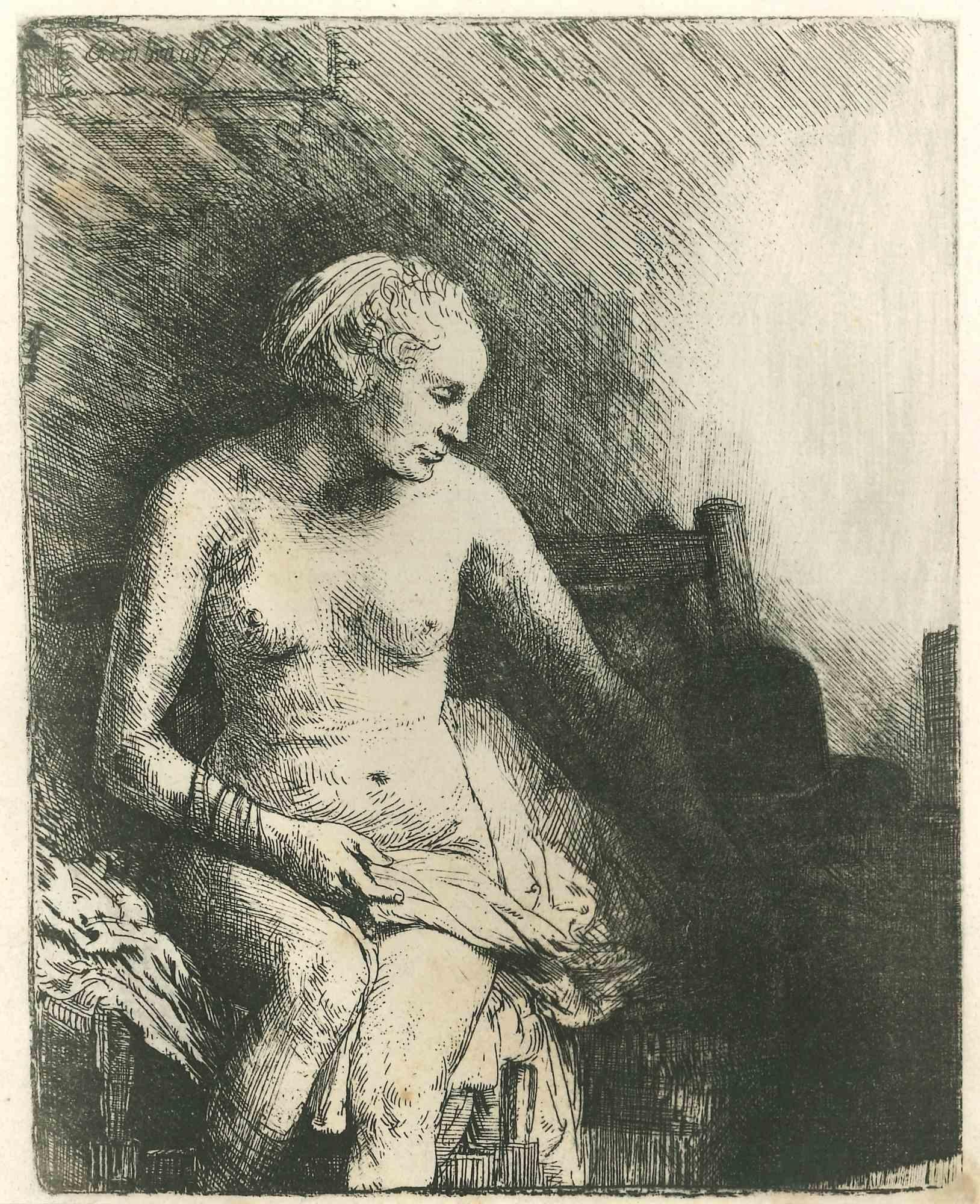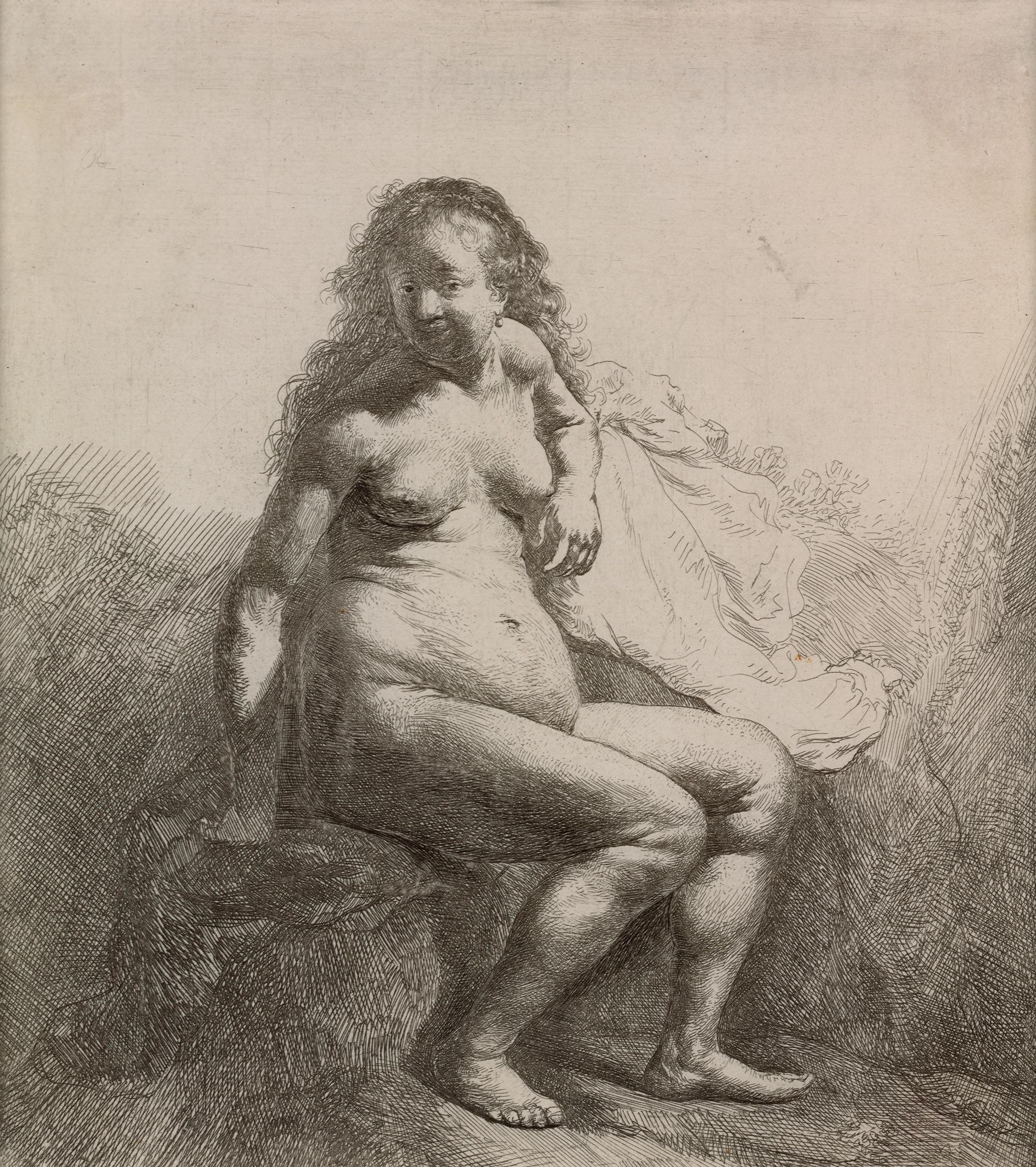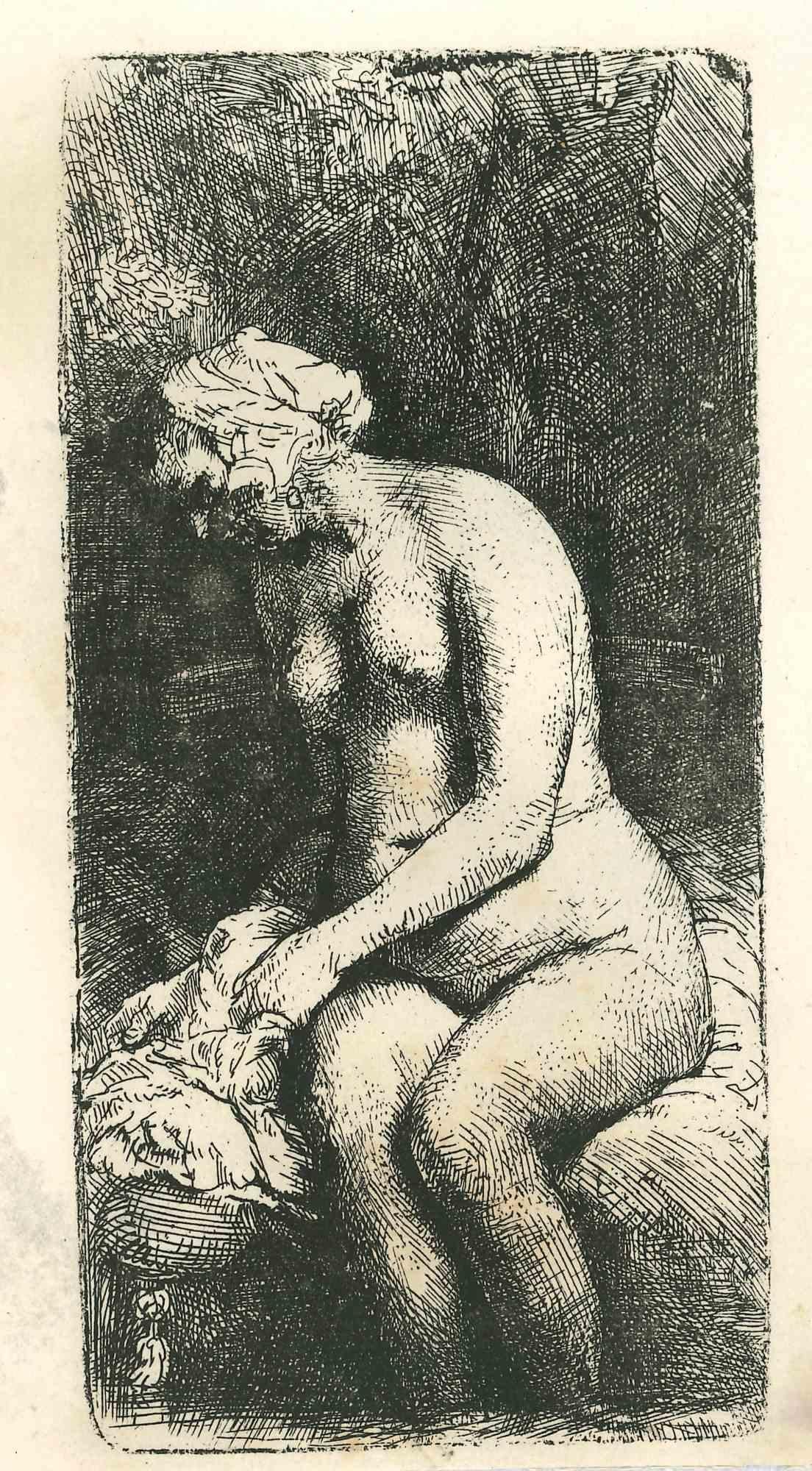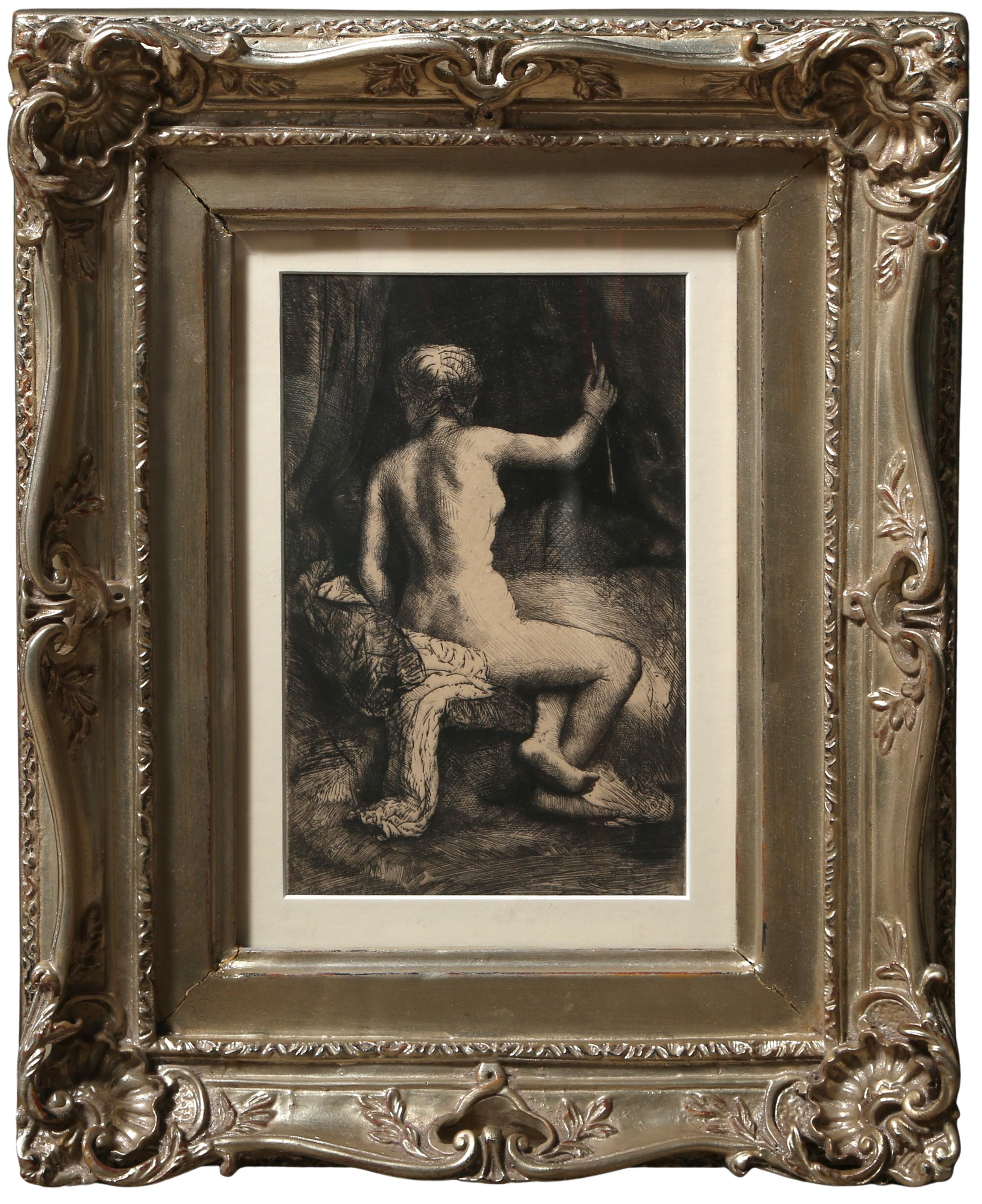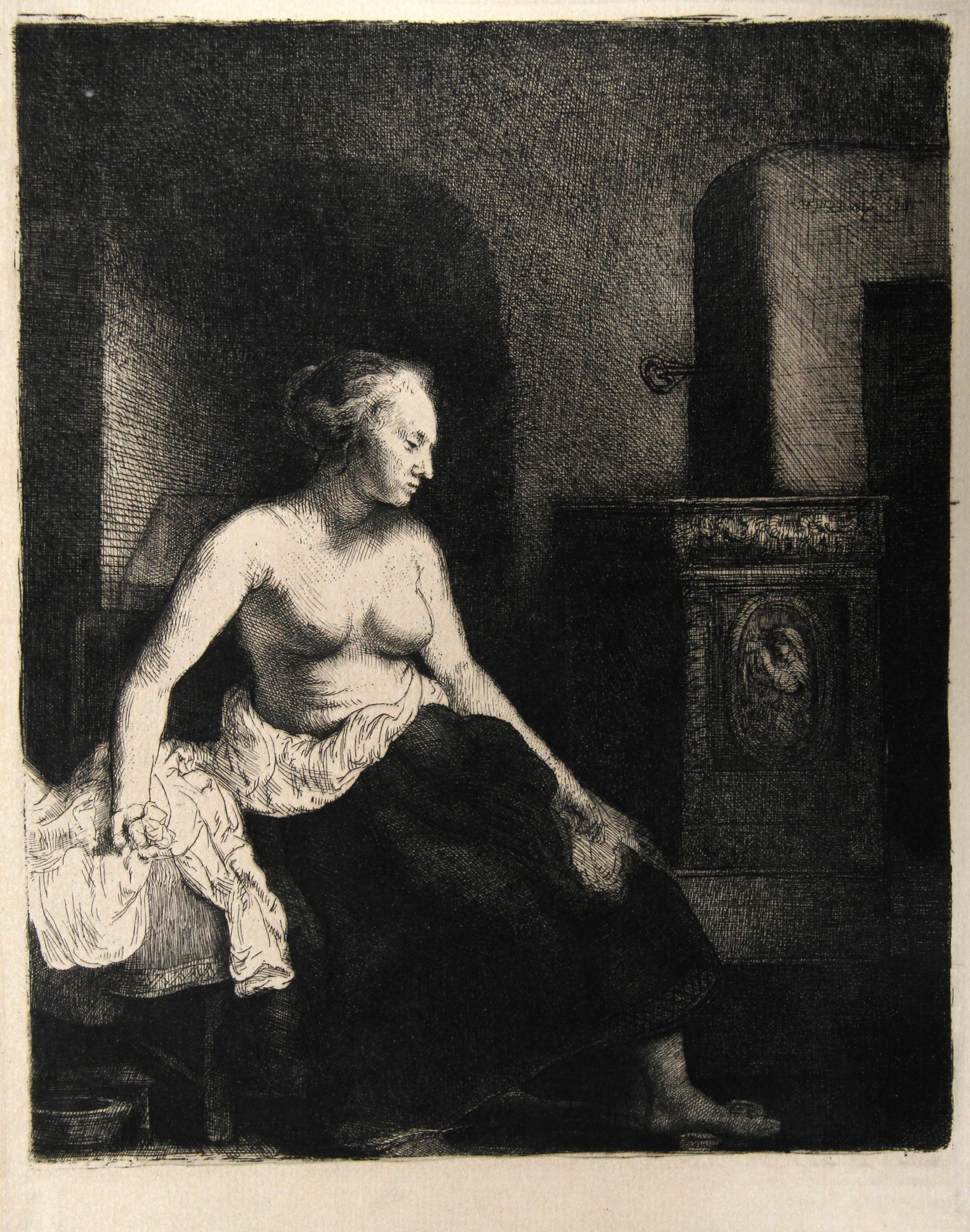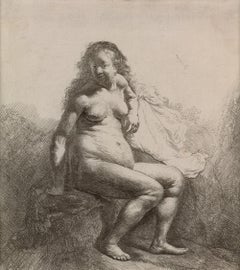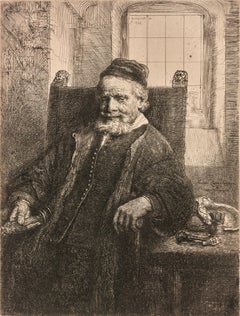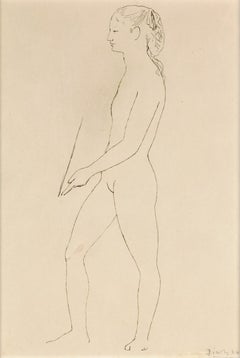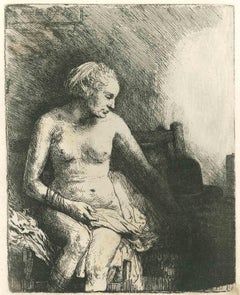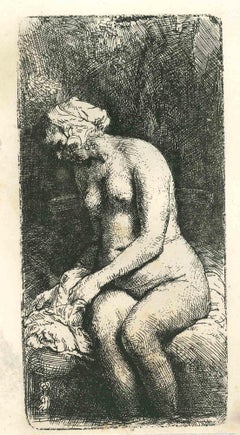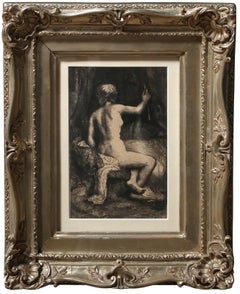Items Similar to Woman Bathing Her Feet in a Brook by Rembrandt van Rijn
Want more images or videos?
Request additional images or videos from the seller
1 of 9
Rembrandt van RijnWoman Bathing Her Feet in a Brook by Rembrandt van RijnCirca 1658
Circa 1658
$34,500
£26,377.09
€30,381.08
CA$48,345.08
A$53,972.73
CHF 28,280.90
MX$660,679.23
NOK 359,167.72
SEK 338,649.56
DKK 226,737.09
Shipping
Retrieving quote...The 1stDibs Promise:
Authenticity Guarantee,
Money-Back Guarantee,
24-Hour Cancellation
About the Item
Rembrandt van Rijn
1606-1669 Dutch
Woman Bathing Her Feet in a Brook
Etching on paper
New Hollstein's 309, second state of II
Signed and dated "Rembrandt f. 1658" (upper left)
Created from observations of a live model, this work started as a figure study before evolving into a more imaginative setting. It remains ambiguous whether the scene is set indoors, as suggested by the cushion the figure is seated on, or outdoors, indicated by the foliage in the background. The omission of her feet, suggesting they may be dangling in a brook, adds a charming touch to Rembrandt’s imaginative scene. The figure seems unaware of the viewer, presenting a dignified yet sensual demeanor.
The son of a miller, Rembrandt van Rijn is believed to have been born in Leiden on July 15, 1606. He studied first at the Latin School and then was enrolled at the University of Leiden at the age of 14. He soon left to study art—first with a local master, Jacob van Swanenburch, and then, in Amsterdam, with Pieter Lastman, known for his historical paintings. Rembrandt was an exceptionally gifted student and mastered his art in a mere six months. Now 22 years old, he returned to Leiden and was soon so highly regarded that he was able to take students of his own.
Though known today primarily for his paintings, Rembrandt's fame spread outside the Netherlands thanks to his etchings. He made hundreds of etchings throughout his career from 1626 until 1660, the year he was forced to sell his presses. He created etchings of many subjects, including self-portraits, biblical subjects, saints and allegories, and his work was avidly admired and collected, even during his lifetime.
Versions of this etching reside in numerous museums, including the Metropolitan Museum of Art in New York, the Art Institute of Chicago and the Cleveland Museum of Art, among many others.
Printed circa 1658
Etching: 6" high x 3 1/8" wide (15.24 x 7.94 cm)
Frame: 17 7/8" high x 14" wide x 1 1/4" deep (45.40 x 35.56 x 7.94 cm)
Provenance:
Unknown collection stamp: cross in oval, not in Lugt.
Private collection
M.S. Rau, New Orleans
Literature:
F. W. H. Hollstein Dutch and Flemish Etchings, Engravings and Woodcuts. vols. 1-64, Amsterdam, 1954–2010, cat. no. B200, p. 97.
F. W. H. Hollstein Dutch & Flemish Etchings, Engravings and Woodcuts, 1450-1700, 2008, cat. no. 309, p. 297, ill.
David Maskill, 'Rembrandt van Rijn 1606-69 Netherlands', in William McAloon (ed.), Art at Te Papa(Wellington: Te Papa Press, 2009), p. 33.
- Creator:Rembrandt van Rijn (1606 - 1669, Dutch)
- Creation Year:Circa 1658
- Dimensions:Height: 17.88 in (45.42 cm)Width: 14 in (35.56 cm)Depth: 1.25 in (3.18 cm)
- Medium:
- Movement & Style:
- Period:
- Condition:
- Gallery Location:New Orleans, LA
- Reference Number:Seller: 32-01261stDibs: LU18615441822
Rembrandt van Rijn
Rembrandt was the most influential 17th Century Dutch painter. After years of early success as a portrait painter, his life was beset by financial hardship and personal tragedy. He continued to paint portraits and develop etchings. Rembrandt's portraits of his contemporaries, self-portraits and illustrations of scenes from the Bible are regarded as his greatest creative triumphs. His self-portraits form a unique and intimate autobiography, in which the artist surveyed himself without vanity and with the utmost sincerity. Like many artists of the Dutch Golden Age, such as Jan Vermeer of Delft, Rembrandt was also an avid art collector and dealer. Rembrandt never went abroad, but he was considerably influenced by the work of the Italian masters and Netherlandish artists who had studied in Italy, like Pieter Lastman, the Utrecht Caravaggists, Flemish Baroque, and Peter Paul Rubens. Rembrandt's foremost contribution in the history of printmaking was his transformation of the etching process from a relatively new reproductive technique into a true art form, along with Jacques Callot. His reputation as the greatest etcher in the history of the medium was established in his lifetime and never questioned since. Few of his paintings left the Dutch Republic while he lived, but his prints were circulated throughout Europe, and his wider reputation was initially based on them alone.
About the Seller
5.0
Vetted Professional Seller
Every seller passes strict standards for authenticity and reliability
Established in 1912
1stDibs seller since 2013
17 sales on 1stDibs
Typical response time: 10 hours
- ShippingRetrieving quote...Shipping from: New Orleans, LA
- Return Policy
Authenticity Guarantee
In the unlikely event there’s an issue with an item’s authenticity, contact us within 1 year for a full refund. DetailsMoney-Back Guarantee
If your item is not as described, is damaged in transit, or does not arrive, contact us within 7 days for a full refund. Details24-Hour Cancellation
You have a 24-hour grace period in which to reconsider your purchase, with no questions asked.Vetted Professional Sellers
Our world-class sellers must adhere to strict standards for service and quality, maintaining the integrity of our listings.Price-Match Guarantee
If you find that a seller listed the same item for a lower price elsewhere, we’ll match it.Trusted Global Delivery
Our best-in-class carrier network provides specialized shipping options worldwide, including custom delivery.More From This Seller
View AllNaked Woman on a Mound by Rembrandt van Rijn
By Rembrandt van Rijn
Located in New Orleans, LA
Rembrandt van Rijn
1606-1669 Dutch
Naked Woman on a Mound
Etching on paper
Etched by Rembrandt
New Hollstein 88, second state of II; Bartsch, Hollstein 198; Hind 43
One of the gr...
Category
17th Century Old Masters Figurative Prints
Materials
Etching
Après le bain (After the bath)
By Pierre Auguste Renoir
Located in New Orleans, LA
For Pierre-Auguste Renoir, Impressionism's pre-eminent figure painter, depicting the nude was an exercise in bringing the canvas to life. He once said, “I look at a nude, I see myriads of minuscule shades. I have to find those which will make the flesh on my canvas come to life and resonate.” This compelling portrait by Renoir entitled Après le bain presents the nude figure of a woman in a serene, private moment, absorbed in the task of drying herself after a bath. The artist’s mastery of light and shading is incredible, achieving a sense of vitality in this otherwise ordinary scene.
Renoir is celebrated for his figural work, especially his Rubenesque female nudes, however, it was not until the artist was in his forties that he depicted the nude with any frequency. In 1881, Renoir traveled to Italy, where he studied the works of the Renaissance masters and the ancient art of Pompeii and Rome. Upon his return to France, the nude became his favored subject, and he used the motif to combine the spontaneity of Impressionism with the solid modeling of classical painting. Renoir’s medium here, sanguine, a reddish-brown chalk, was used extensively in the Renaissance by Leonardo (who employed it in his sketches for the Last Supper), Michelangelo and Raphael. Its warm hue lends itself well to depicting flesh, and the chalk drawing allows for a greater focus on line, form and texture in a departure from the aspects of color and light that so often preoccupied the Impressionists. Après le bain conveys the impression of arrested motion with perfect naturalness, deftly capturing the moment before the elegant lines of the sitter's form change position.
The sitter is almost certainly Gabrielle Renard, the nanny to Renoir’s children and a frequent model for the artist. Gabrielle was the cousin of Renoir’s wife, Aline, and came to Montmartre to work for the family at the age of 16. She developed a strong bond with the family and became a favorite subject for Renoir, appearing in several of his most important works, including his 1911 Gabrielle with a Rose (Musée d'Orsay). When Renoir began to suffer from severe rheumatoid arthritis that would eventually leave him unable to walk and scarcely able to grasp a paintbrush, it was Gabrielle that would assist the artist by positioning the paintbrush between his crippled fingers.
Born in Limoges, France in 1841, Renoir began his career as an apprentice to a painter of porcelain wares. He later moved to Paris at the age of 21, enrolling at the prestigious École des Beaux-Arts. It was here, while studying under Charles Gleyre, that Renoir attained a tremendous appreciation for the academic style of painting, a quality that would last throughout his career. This was also when he met Claude Monet and several other classmates, with whom he would later form the Impressionists.
Working closely with Monet, Renoir began experimenting with the portrayal of light and its effect on his canvases. The youngest member of the Impressionist movement, an astute Renoir recognized how a subject was constantly changing due to the dynamic effects of light on color. Relying heavily upon his academic training that focused on composition, lines and descriptive details, Renoir distinguished himself among his contemporaries. His intuitive use of color and expansive brushstroke, along with acute attention to his subject, have placed him among the finest painters in history.
This work is accompanied by a certificate of authenticity and will be included in the forthcoming catalogue raisonné of the work of Pierre-Auguste Renoir from the Wildenstein Plattner Institute.
Circa 1898
Canvas: 43 1/2" high x 35 1/2" wide
Frame: 57 3/4" high x 49 1/4" wide
Provenance:
Galerie Durand-Ruel, Paris (acquired from the artist on January 25, 1899)
J. Pereire Collection, France (1966)
Sam Salz, New York (before 1981)
Claus Virch, Paris
French Compagny, Inc., New York
Larry Silverstein, New York (circa January 1987)
Le Clos de Sierne Gallery, Geneva
Galerie Heyram, Paris (October 1987)
Francis Gross
M.S. Rau, New Orleans
Literature:
B. Schneider, Renoir, Berlin, 1957, p. 95 (illustrated in color, p. 83)
M. Gauthier, Renoir, Paris, 1958, p. 83 (illustrated in color; erroneously dated '1916' and titled 'Woman in her toilet')
F. Fosca, Renoir, L'homme et son obra, Paris, 1961, p. 280 (illustrated, p. 95; erroneously dated 'about 1890' and titled 'After the Bath...
Category
19th Century Impressionist Nude Paintings
Materials
Canvas, Paper, Chalk
Price Upon Request
Jan Lutma, Goldsmith by Rembrandt van Rijn
By Rembrandt van Rijn
Located in New Orleans, LA
Rembrandt van Rijn
1606-1669 Dutch
Jan Lutma, The Goldsmith
Etching, engraving, and drypoint on paper
New Hollstein’s second state of five
Signed and dated “Rembrandt / F. 1656” (...
Category
17th Century Old Masters Figurative Drawings and Watercolors
Materials
Paper, Engraving, Drypoint, Etching
Nu tenant un miroir by Pablo Picasso
By Pablo Picasso
Located in New Orleans, LA
Pablo Picasso
1881-1973 Spanish
Nu tenant un miroir
(Nude holding a mirror)
Signed "Picasso" (lower right)
Pen and ink on paper
Pablo Picasso's Rose Period is among the most icon...
Category
Early 20th Century Nude Drawings and Watercolors
Materials
Paper, Ink, Pen
Femme mettant ses bas by Maximilien Luce
By Maximilien Luce
Located in New Orleans, LA
Maximilien Luce
1858-1941 French
Femme mettant ses bas
(Woman putting on her stockings)
Pastel on paper
Signed "Luce 89" (lower left)
Maximilien Luce’s Femme mettant ses bas is a...
Category
19th Century Post-Impressionist Figurative Drawings and Watercolors
Materials
Paper, Pastel
Japanese Shunga, Sitting Woman
Located in New Orleans, LA
A beautiful example of the Japanese art form known as shunga, this sensual work depicts woman exploring her sexuality. Hand-painted on paper with splashes of vivid gouache color, the...
Category
Early 20th Century Other Art Style Nude Drawings and Watercolors
Materials
Paint, Paper, Gouache
You May Also Like
Woman in the Bathroom I - Engraving After Rembrandt - 19th Century
By Charles Amand Durand
Located in Roma, IT
Woman in the Bathroom I is an engraving on ivory-colored paper realized by Charles Amand Durand after an etching by Rembrandt of 1658. This specimen belongs to an edition of the late...
Category
19th Century Old Masters Figurative Prints
Materials
Engraving
Seated Woman Holding her Shirt - Engraving after Rembrandt - 19th Century
By Charles Amand Durand
Located in Roma, IT
Seated Woman Holding her Shirt is an engraving on ivory-colored paper realized by Charles Amand Durand after an etching by Rembrandt dated 1658.
This wonderful piece of art belongs ...
Category
19th Century Old Masters Figurative Prints
Materials
Engraving
Seated Woman Holding her Shirt - Engraving after Rembrandt - 19th Century
By Charles Amand Durand
Located in Roma, IT
Seated Woman Holding her Shirt is an etching on ivory-colored paper realized after an etching by Rembrandt dated 1658. This wonderful piece of art belongs to an edition of the late 1...
Category
19th Century Modern Figurative Prints
Materials
Engraving
La Femme a la Fleche, Old Masters Heliogravure Etching by Rembrandt van Rijn
By Rembrandt van Rijn
Located in Long Island City, NY
Artist: Rembrandt van Rijn, After by Amand Durand, Dutch (1606 - 1669) - La Femme a la Fleche (B202), Year: 1878 (of original 1661), Medium: Heliogravure, Size: 8.25 x 5 in. (20.96...
Category
Late 19th Century Old Masters More Prints
Materials
Etching
Woman Seated Beside a Stove (B197), Heliogravure by Rembrandt van Rijn
By Rembrandt van Rijn
Located in Long Island City, NY
Artist: Rembrandt van Rijn, After by Amand Durand, Dutch (1606 - 1669) - Woman Seated Beside a Stove (B197), Year: 1878 (of original 1658), Medium: Heliogravure, Size: 9 x 7.25 in...
Category
Late 19th Century More Prints
Materials
Etching
Le Lavement des Pieds - Lithograph d'Après Rembrandt by Léopold Flameng
By Léopold Flameng
Located in Roma, IT
Le Lavement des Pieds is an original artwork realized by Léopold Flameng in the second half of the XX century.
Etching on paper d'aprés Rembrandt.
Go...
Category
1880s Modern Nude Prints
Materials
Lithograph
Read More
Paul Revere Crafted This Silver Coffee Pot 250 Years Ago
Perhaps best known as a Revolutionary War hero, Revere was also an accomplished silversmith, and this pot is now available on 1stDibs.
Degas Portrayed These Exuberant Ukrainian Dancers with ‘Orgies of Color’
Discovered in Parisian cabarets, the performers reenergized the artist’s practice.
More Ways To Browse
Rembrandt Paintings
Van S Painting
Antique Paper Press
Painting Bathing
David Miller
Woman With Cat Painting
Antique Cat Collection
8 Feet Paintings
Rembrandt Self Portrait
Antique Black Cat
Set Of 6 Etchings
Rembrandt Self Portrait Etching
Rembrandt Van Rijn Etching
Woman Bathing Art
Rembrandt Etching Amsterdam
Rembrandt Student
New Orleans Etching
Antique Stamp Press
